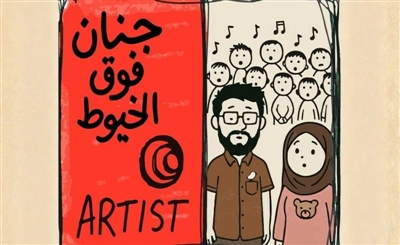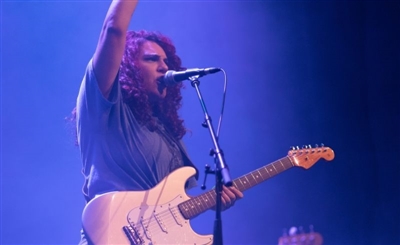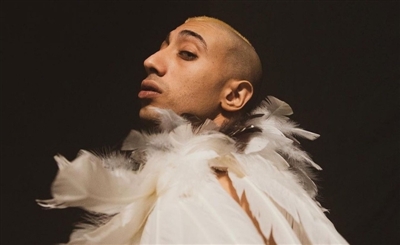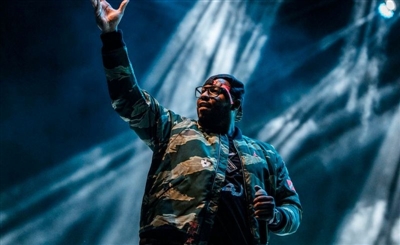Theatrics of Life: Aia Atoui Dives into the Human Condition
Visual artist and DJ, Aia Atoui, reflects on the endurance of performance and music amidst on going turmoil in Beirut.
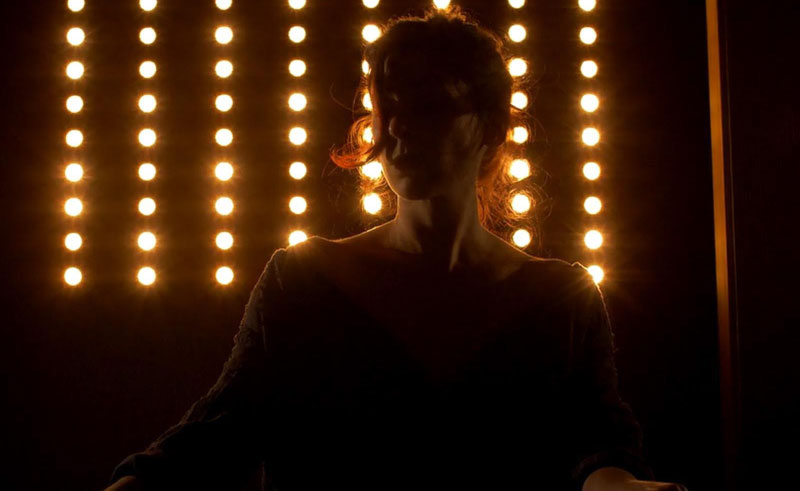
In the time of confinement, Aia Atoui picks up a camera and finds herself studying her neighborhood. She generates an affinity for sitting on her balcony to observe the passers-by, capturing strangers in a moment of existential unraveling as they stand and stare at nothing, or come around at the usual time to perform their small part in the grand stage of the mundane. As she captures the candid moments of her subjects, in a manner that is almost creepy and eye-opening, she becomes a vessel in a way, through which the world around her speaks. She wonders if she’s a vessel to her own projections onto the world or if that’s how the world really is, I wonder what’s the difference. Visual artist and DJ, Aia Atoui, takes an exploratory dive into the human condition, creating emotionally-driven visual experiences.
Aia describes her journey through sound by telling the story of how she first started playing club nights at the Ballroom Blitz after moving to Beirut in 2016. Laptop in hand, she first played eclectic sets traversing a spectrum of genres. Coming from no technical background, she was an intuitive selector who was met by a club and crowd brimming with curiosity.
“I thought no one would take me seriously playing on Virtual DJ. To play a track and then stop, play, stop, play, which is what I was doing, heavily inspired by The Gaslamp Killer sets.” Soon after Aia started honing her skills with the support of club co-founder Moe Choucair, who gave her guidance to mastering the standard Pioneer Mixer. She was instantly taken aback by the potential of what she calls “a gargantuan mothership of a machine.”
This marked a turning point for her as she swerved in her musicality, evolving from performing genre-bending sets to incorporating an artistic reinterpretation of human emotion. The emergence of her stage-name ShwayShway served as an ode to her slow-paced, overanalyzing self. “Whenever I would hear the term Shway Shway it really resonated with me, because I’m like yeah totally, my motto is Shway Shway, everything I do is quite premeditated, I overanalyze things a lot before I do them.”
Atoui maneuvers the decks with a rhythmic, contemplative flow. Often without headphones, she mixes Chicago footwork beats with resonant classical music, pushing boundaries and sound textures. Fluctuating between carefully-timed climaxes, she uses the repetitive progression of her beats and the emotional complexity of her classical samples to create scenic sets. The listener is able to live vicariously through the soundscapes as she performs stories of love and agony, death and joy, body and soul. To her ears, these two genres merge with a distinct synergy, like water and air as she describes it. “Ultimately, footwork also has this emotionality in it. There’s something about it that’s quite militant and aggressive, and it feels very angry. It’s very understood why it’s angry from the subculture that formulates within Chicago.”
Growing up listening to hip-hop, footwork became a natural inclination for Atoui. While she is captivated by the physicality of the genre, especially in the view that a dance movement helped give birth to the music, she also connects with and generates depth from the real stories and suffering behind its origin culture: how young kids would use performance as a medium to express their grievances, and further still, how beatmakers gave them a gift of sound that encouraged their pursuit of greatness.
Aia's musical inspiration often derives from cinema, especially horror movie scores, which she believes can make or break the picture. “The last footwork mix I worked on was sampled from the 1974 horror film ‘Carrie’... There’s a reason why I watched the film as many times as I did, there’s something about it that I held onto. The sound, Carrie as a character, the people around her.”
She is fascinated by how classical music can function as a dramatic depiction of the human condition: polarized, erratic, and compressed. Yet ultimately, when it comes down to picking her music and weaving her sets, she is guided by a deeper subconscious and emotionally-driven intuition.
“It just sort of comes out. I’d relate to the sample - like there would be something about the sample that’s really beautiful that I correlate with, and I correlate to it for a particular reason, for a particular experience - and it comes out; but I don’t know what it means. There are times I do know, but not always.”
An emotional element spills into her visual and sonic work as she observes, partakes in, and seeks to capture the undertones of this theatrical performance we call life.
In 2019, Aia produced one of her most confrontational and cathartic art interventions reinterpreting ‘Liebestod’, an excerpt of Wagner’s 19th century opera ‘Tristan Und Isolde’ in Beirut’s abandoned Grand Theatre. Inspired by the rushing flood of emotions in the early days of the uprising and in the flourish when people reclaimed privatised spaces like the theatre, she dreamt of what it would sound and look like if it was still open for the world, if it hadn’t been shattered by the country’s civil war or buried by the suits of Beirut’s neoliberal development era.
She recollects upon first meeting Anthony Sahyoun, one of Beirut’s most promising pioneers of experimental music, and how they’d share pieces from Tristan Und Isolde long before ever considering reinterpreting it. As Aia walks into the war-torn Grand Theatre for the first time, she absorbs the heavy memories of high ceilings which once echoed music and art, before being forsaken to conceal the ghosts of Beirut’s past. She discusses these feelings with Sahyoun, and almost as a natural reaction, ‘Shabah El Reeh’ was born. “When we decided to do the project, we knew: ‘this is it’. This was the moment to reinterpret it, and Anthony created this massive opera piece.”
Months into the October uprising, on a cobblestoned alleyway facing the Lebanese parliament, hundreds of people stood outside in the shadow of the overarching Grand Theatre, using everything from rocks, pans, and bare fists to bang on its walls. As the people created cacophonic symphonies of rage and war to stir awake what had been long-forgotten, Aia and a group of artists were capturing a symphony of séances on the inside. With the help of Whard Sleiman on set-design and Nader Bahsoun on cinematography, the team set up the production. Sneaking into the theatre and illuminating their steps using phone torches, they would build improvised ladders to hang wires up high, and figure out methods of generating electricity for the space. Elsewhere, Sahyoun was carefully composing the music and working with Lebanese Soprano Mona Hallab to prepare for an eerie course-defining performance. Aya wanted to capture the many unsettling, grand emotions of the space. But she was also tapping into the emotional turmoil of the city.
“The suffering of forbidden love, that’s what ‘Liebestod’ is about. Tristan and Isolde couldn’t be together, and they consummated their love after Tristan had died. If you directly translate ‘Liebestod’ to English, it’s ‘love-death’. So, it’s the concept of Isolde singing over Tristan’s dead body as she watches his resurrection, there’s this violent optimism, you can hear it in her voice, and even in the lyrics. She’s watching him and asking, ‘can you see?’ He’s literally rising from the dead, ‘am I crazy?’ She starts wailing with this almost delusional optimism, which was very prevalent on the streets. There was suffering and there was optimism.”
Between an uprising and a pandemic, the project was developed at a relentlessly volatile time for the city. Amidst the uncertainty, the concept and execution pivoted from what was originally planned, and Aia was faced with internal doubts and external obstructions that prolonged their production process. “It took a year. It was partially on me that it took that long because I was really afraid of a lot of things... There was a moment throughout the year that I felt like there was a wall in front of me and I wasn’t able to go through with it yet.”
After a year in the making, “Shabah El Reeh” unlocks a completely unpredicted depth as Beirut falls victim to a massive explosion that took the lives of hundreds and obliterated a chunk of the city including its central port. Aia and the team felt the urgency to release their work to the world, this timely, electrifying, melancholic performance of the violence, catharsis, and surrealism of love after death, what it sounds and looks like to be a ghost or to be longing for one, the ear-piercing wail of spirits in a dead house of song.
“Nobody knows why it got drawn out as long as it did, but after the explosion, we just felt the need to release it immediately. For us, it meant a huge deal to just release it... It was a catalysation process, and that was the time.”
Aia continues to experiment in new mediums with an aura of mysticism and haunting truth. In her exploration of raw emotion, she captures the undertones of life in theatrical pieces that keep us questioning the depth of our inhibitions, the delusions of our perception, and if nothing else, the grand absurdity the grand absurdity of living.
- Previous Article test list 1 noise 2024-03-13
- Next Article Nadine El Roubi Addresses Egypt’s Rap Scene in New ‘Butcher Freestyle’
Trending This Month
-
Nov 24, 2025



